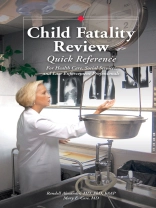400 pages, 150 images, 77 contributors
Child Fatality Review Quick Reference features the best practices in the investigation of child death. It is a valuable resource both for active members of child fatality review teams (CFRTs) and for any professionals who collaborate with CFRTs in the process of child death review. This detailed reference is exhaustive in scope yet conveniently sized to suit the needs of frontline practitioners working in crime scenes, in the courtroom, or in the medical setting.
This reference describes in full the respective roles and responsibilities of CFRT members, from coroners and medical examiners, to law enforcement and district prosecutors, as well as a variety lay investigators, community representatives, and child welfare personnel. CFRT professionals across disciplines will all benefit from this in-depth guide to investigative protocols for all manner of abusive and negligent, accidental, and natural death in children.
Tabela de Conteúdo
1. Fatality Review Teams
2. Fatality Review Procedures
3. Epidemiology of Child Fatality
4. Pediatric Ophthalmology
5. Law Enforcement, Courts, and CPS
6. Social and Environmental Issues
7. Homicides
8. Perinatal Deaths
9. Sudden Infant Death Syndrome (SIDS)
10. Physical Abuse
11. Neglect
12. Nonabusive Injuries
13. Suicides
14. Burns
15. Drownings
16. Medical Conditions
Sobre o autor
Mary Case is a graduate of the University of Missouri-Columbia and the Saint Louis University School of Medicine. She completed her residency training in pathology at the Saint Louis University Health Sciences Center and is board certified in anatomical pathology, neuropathology, and forensic pathology. In addition to being a professor of pathology and codirector of the Division of Forensic Pathology at St. Louis University Health Sciences Center, Dr. Case serves as chief medical examiner for the cities of St. Louis and St. Charles, and Jefferson and Franklin Counties. Her primary practice is forensic pathology, and her areas of special interest are childrens’ injuries and head trauma.












